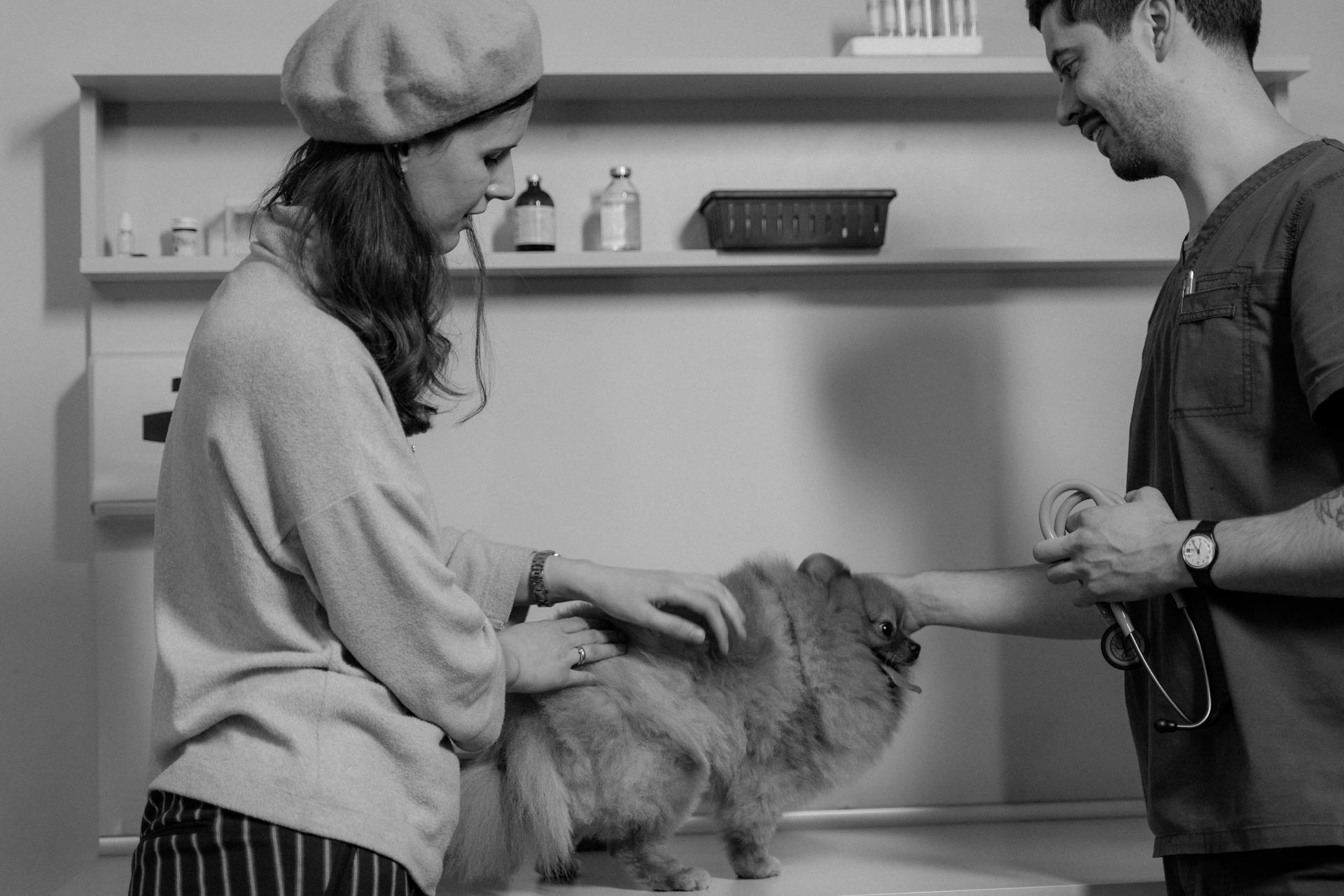
UTIs in female dogs can be a real pain for both the dog and the owner.
One of the most common signs of a UTI in a female dog is frequent urination, often accompanied by accidents in the house.
Dogs with UTIs may also exhibit straining or difficulty when urinating, which can be a sign that something is wrong.
A UTI can be caused by a bacterial infection, which can be prevented by keeping your dog's genital area clean and dry, especially after exercise or playtime.
What Is a UTI?
A UTI, or urinary tract infection, is a common issue in dogs. It occurs when bacteria like E coli, Enterococcus, Staphylococcus, or Streptococcus set up shop in your dog's bladder or kidneys.
Most UTIs are caused by E coli, which accounts for 40-50% of bladder infections in dogs. In fact, in some cases, multiple species of bacteria can contribute to the infection, with up to 30% of cases involving more than one type of bacteria.
The letters UTI stand for urinary tract infection, and it's a serious issue that needs attention.
Related reading: Urinary Catheter Female Dog
Signs and Symptoms
If your female dog is suffering from a UTI, you might notice her frequent urination, straining to pass urine, or passing small amounts of urine at a time.
Blood in the urine is a common symptom of UTIs in dogs, and you may notice it when you take her to the vet for a check-up.
Licking the genital area excessively is another sign that your dog may be experiencing a UTI, and it's often accompanied by lethargy and changes in appetite or thirst.
Here are some common signs and symptoms of UTIs in female dogs:
- Frequent urination
- Straining to urinate
- Passing small amounts of urine at a time
- Licking the genital area excessively
- Blood in the urine
- Lethargy
- Changes in appetite or thirst
You may also notice that your dog is whining or whimpering while urinating, or that she's licking the genital area more often than usual.
Cloudy or strong-smelling urine can also be a sign of a UTI, and it's essential to keep an eye on these symptoms to ensure your dog gets the proper treatment.
Consider reading: Dog Names Female Start with S
Causes and Risk Factors
Female dogs are more prone to UTIs, and several factors can contribute to the development of these infections. Certain medical conditions can impact the urinary tract, making it more susceptible to UTIs.
Diabetes in dogs can lead to UTIs, as the high blood sugar levels can change the composition of the urine and make it a breeding ground for bacteria. This is a common issue in dogs with diabetes.
Holding urine for too long can also contribute to UTIs in female dogs. This allows bacteria to multiply and cause infections. Poor hygiene is also a factor, as bacteria can easily spread and cause infections.
Other health issues, such as kidney failure and urinary stones, can also increase the risk of UTIs in female dogs. These conditions can damage the urinary tract and make it more vulnerable to infections.
Certain anatomical abnormalities, such as ectopic ureters and recessed vulva, can also contribute to UTIs in female dogs. These conditions can trap moisture and bacteria, making it easier for infections to develop.
Here is a list of conditions that can increase the risk of UTIs in female dogs:
- Diabetes in dogs
- Cushing’s disease in dogs
- Kidney failure in dogs
- Urinary stones
- Recent indwelling urinary catheter placement
- Urinary incontinence in dogs
- Ectopic ureters (ureters that don’t insert into the correct location on the bladder)
- Recessed vulva in dogs (i.e. excessive skin folds around the vulva that trap moisture and bacteria)
- Cancer somewhere in the urinary tract (e.g. bladder cancer in dogs or prostate cancer in dogs)
Diagnosis and Treatment
A urine sample is crucial for diagnosing a UTI in your female dog. Your vet will likely perform a urinalysis and a bacterial culture on the sample to confirm the diagnosis.
If your vet confirms a UTI, antibiotics will be the primary treatment. The specific antibiotics and treatment duration will depend on the infection's severity and underlying cause.
Your vet may also recommend additional tests like X-rays or an ultrasound examination to rule out underlying conditions such as bladder stones, prostate issues, or anatomical abnormalities.
Curious to learn more? Check out: Will Spaying Calm a Female Dog
Urinalysis
Urinalysis is a crucial step in diagnosing urinary tract infections in dogs. A sterile sample from the dog's bladder is often the most accurate way to determine the presence of a UTI.
Your veterinarian may perform a urinalysis to check for markers of infection, such as blood or glucose, and to examine the urine under a microscope for bacteria, red and white blood cells, and urine crystals. This can help identify underlying issues like bladder stones or diabetes.
Suggestion: Older Female Dog Blood Clot in Urine
Collecting a sterile urine sample can be done through cystocentesis, a safe and common procedure that involves drawing urine directly from the bladder using a needle. This method is often preferred over a free-catch sample, which can be contaminated with bacteria from the urethra and surrounding skin.
A free-catch sample, on the other hand, may not provide an accurate diagnosis, especially if the dog has a UTI. This is because the sample may contain bacteria from the urethra and surrounding skin, rather than just the bladder.
Your veterinarian may still be able to assess the presence of a UTI based on a free-catch sample, but additional tests like a urinalysis or culture may be necessary to confirm the diagnosis.
Curious to learn more? Check out: Where Can I Get My Female Dog Fixed for Free
Treatment for
Treatment for UTIs in dogs typically involves antibiotics, which are prescribed by a veterinarian. The specific antibiotics and treatment duration depend on the infection's severity and underlying cause.
Antibiotics are usually prescribed for a course of treatment, and it's essential to complete the full course, even if symptoms seem to improve before the medication is finished.
See what others are reading: Female Dog Prolapse

In some cases, anti-inflammatory medications or painkillers may also be recommended to alleviate discomfort and inflammation.
A comprehensive evaluation is crucial to ensure your dog gets the right care, as UTIs can sometimes be confused with other conditions that have similar symptoms.
Your veterinarian may also recommend additional tests like X-rays or an ultrasound examination to identify underlying bladder stones, prostate issues, tumors, or anatomical abnormalities.
A urine sample is needed to diagnose bacterial cystitis, and the laboratory tests your veterinarian will likely perform on the sample are a urinalysis and a bacterial culture.
Treatment for bacterial cystitis consists of antibiotics given by mouth for 2 weeks (simple infections) or longer, if needed.
Your veterinarian may take more urine samples during and after treatment to make sure the medications have cured the infection.
In dogs that have repeated infections, your veterinarian may take a urine sample at regular intervals (about every 1 to 3 months) to make sure the infection has not come back.
On a similar theme: Female Dog Incontinence Treatment
Prevention and Proactive Care
To prevent UTIs in dogs, several measures can be taken. Regularly cleaning the genital area is crucial for good hygiene, especially for dogs with longer fur around the urinary opening.
Keeping a "mental journal" of your dog's bathroom habits can help you recognize early signs of a UTI. This means watching for changes in your dog's behavior, such as increased frequency or urgency of urination.
Ensuring your dog has access to fresh and clean water, promoting regular urination and bathroom breaks, and avoiding prolonged holding of urine can also help prevent UTIs. Scheduling routine veterinary check-ups is also essential, especially for senior dogs or those with predisposing factors.
Here are some key steps to take:
- Regularly clean your dog's genital area
- Keep a "mental journal" of your dog's bathroom habits
- Ensure access to fresh and clean water
- Promote regular urination and bathroom breaks
- Avoid prolonged holding of urine
- Schedule routine veterinary check-ups
By following these steps, you can help reduce your dog's risk of developing a UTI and ensure they receive the best possible care.
How to Prevent
Prevention is key when it comes to keeping your dog's urinary health in check. Regularly cleaning your dog's genital area is a crucial step in preventing UTIs.
On a similar theme: Why Does My Male Dog Lick My Female Dog's Pee

Providing access to fresh and clean water is essential for your dog's overall health, and it can also help prevent UTIs.
Promoting regular urination and bathroom breaks can also help prevent UTIs. This means taking your dog out more often, especially after meals and playtime.
Avoiding prolonged holding of urine is also important, as this can increase the risk of UTIs.
Promptly addressing any underlying health conditions that may increase the risk of UTIs, such as diabetes or anatomical abnormalities, is crucial.
Early Detection + Proactive Pet Parent + Vet
Early detection is key to preventing urinary tract infections (UTIs) in dogs. By being observant and proactive, you can recognize early signs of a UTI and get your dog the help they need.
Keeping a mental or actual journal of your dog's bathroom habits can help you catch changes early. This includes watching for increased frequency, accidents in the house, and blood in the urine.

If you suspect your dog has a UTI, don't wait or wonder – make an appointment with your veterinarian. Catching UTIs early can prevent them from getting worse and turning into a more serious condition.
Regular physical exams with your veterinarian can also help detect UTIs. Senior dogs (seven years or older) may benefit from more frequent visits, at least biannually. This can help catch UTIs before they become serious.
If your dog has predisposing factors, such as a neurologic condition or certain diseases, be extra vigilant for UTI signs. Medications that increase the risk of UTIs should also be discussed with your veterinarian.
Here's a list of potential UTI signs to watch for:
- Frequent urination
- Painful or difficult urination
- Urinating in inappropriate places
- Blood in the urine
- Dark staining or abnormal discharge from the vulva (in female dogs)
By being proactive and working with your veterinarian, you can help your dog live a happy and healthy life.
Dog Home Remedies
Home remedies can provide some relief for your dog's overall urinary health.
Promoting proper hydration is essential, as it helps to flush out bacteria and other toxins that can cause UTIs.
Providing a clean and stress-free environment is also crucial, as stress can exacerbate urinary issues.
Maintaining good hygiene, such as cleaning your dog's food and water bowls regularly, can also support their urinary health.
Frequently Asked Questions
Can a female dog UTI go away on its own?
No, a female dog's UTI typically requires veterinary attention to clear up, as it can lead to severe complications if left untreated. Consult your vet for proper diagnosis and treatment.
How do you treat cystitis in female dogs?
Treatment for cystitis in female dogs typically involves antibiotics for bacterial infections, and dietary changes or surgery for bladder stones. Consult a veterinarian for a proper diagnosis and treatment plan tailored to your dog's specific needs.
How can you tell if a female dog has a bladder infection?
Common signs of a bladder infection in a female dog include painful urination, blood in the urine, and frequent small amounts of urine. Look for straining to urinate, a key indicator that your dog may need veterinary attention
Can I give my dog anything over the counter for a UTI?
Over-the-counter antibiotics may be available for dog UTIs, but consult a vet first to ensure safe and effective treatment
What do vets give female dogs for UTI?
Vets typically prescribe antibiotics to treat UTIs in female dogs, with additional medications like anti-inflammatories or painkillers used in severe cases. Consult with your veterinarian for a proper diagnosis and treatment plan for your dog's UTI.
Sources
- https://www.merckvetmanual.com/dog-owners/kidney-and-urinary-tract-disorders-of-dogs/infectious-diseases-of-the-urinary-system-in-dogs
- https://toegrips.com/urinary-tract-infections-in-dogs/
- https://www.matthews.carolinavet.com/site/pet-health-blog/2023/04/15/bladder-infection-dog
- https://bettervet.com/resources/pet-health-care/uti-in-dogs
- https://clarionanimalhospital.com/urinary-tract-infections-in-dogs/
Featured Images: pexels.com


